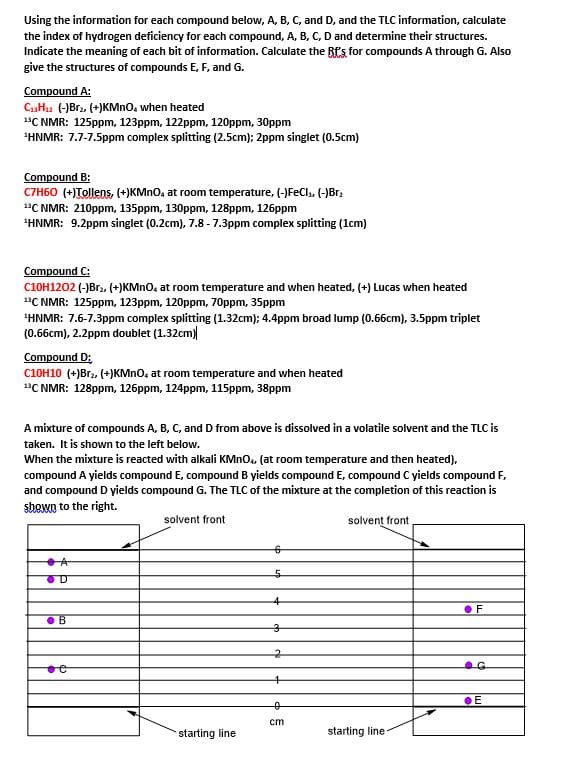Using the information for each compound below, A, B, C, and D, and the TLC information, calculate the index of hydrogen deficiency for each compound, A, B, C, D and determine their structures. Indicate the meaning of each bit of information. Calculate the Bf's for compounds A through G. Also give the structures of compounds E, F, and G. Compound A: CuHa (-)Bra, (+)KMNO, when heated "C NMR: 125ppm, 123ppm, 122ppm, 120ppm, 30ppm *HNMR: 7.7-7.5ppm complex splitting (2.5cm); 2ppm singlet (0.5cm) Compound B: C7H60 (+)Tollens, (+)KMNO, at room temperature, (-)FeCls, (-)Br. 1°C NMR: 210ppm, 135ppm, 130ppm, 128ppm, 126ppm *HNMR: 9.2ppm singlet (0.2cm), 7.8 - 7.3ppm complex splitting (1cm) Compound C: C10H1202 (-JBr2, (+)KMNO, at room temperature and when heated, (+) Lucas when heated "C NMR: 125ppm, 123ppm, 120ppm, 70ppm, 35ppm HNMR: 7.6-7.3ppm complex splitting (1.32cm); 4.4ppm broad lump (0.66cm), 3.5ppm triplet (0.66cm), 2.2ppm doublet (1.32cm) Compound D: C10H10 (+)Brz, (+)KMNO, at room temperature and when heated "C NMR: 128ppm, 126ppm, 124ppm, 115ppm, 38ppm A mixture of compounds A, B, C, and D from above is dissolved in a volatile solvent and the TLC is taken. It is shown to the left below. When the mixture is reacted with alkali KMno., (at room temperature and then heated), compound A yields compound E, compound B yields compound E, compound C yields compound F, and compound D yields compound G. The TLC of the mixture at the completion of this reaction is shown to the right. solvent front solvent front • B oe •E cm atarting line
Analyzing Infrared Spectra
The electromagnetic radiation or frequency is classified into radio-waves, micro-waves, infrared, visible, ultraviolet, X-rays and gamma rays. The infrared spectra emission refers to the portion between the visible and the microwave areas of electromagnetic spectrum. This spectral area is usually divided into three parts, near infrared (14,290 – 4000 cm-1), mid infrared (4000 – 400 cm-1), and far infrared (700 – 200 cm-1), respectively. The number set is the number of the wave (cm-1).
IR Spectrum Of Cyclohexanone
It is the analysis of the structure of cyclohexaone using IR data interpretation.
IR Spectrum Of Anisole
Interpretation of anisole using IR spectrum obtained from IR analysis.
IR Spectroscopy
Infrared (IR) or vibrational spectroscopy is a method used for analyzing the particle's vibratory transformations. This is one of the very popular spectroscopic approaches employed by inorganic as well as organic laboratories because it is helpful in evaluating and distinguishing the frameworks of the molecules. The infra-red spectroscopy process or procedure is carried out using a tool called an infrared spectrometer to obtain an infrared spectral (or spectrophotometer).

Trending now
This is a popular solution!
Step by step
Solved in 2 steps with 2 images




